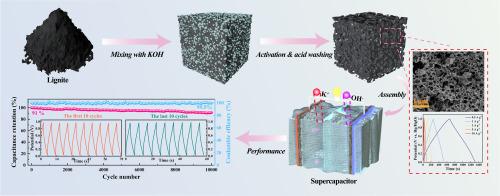高性能超级电容器用褐煤基多孔碳的制备及孔隙结构与电化学性能之间的相关性
IF 8.9
2区 工程技术
Q1 ENERGY & FUELS
引用次数: 0
摘要
多孔碳因其卓越的导电性和可调节的孔隙结构,在储能领域具有相当大的潜力。然而,不合理的孔隙结构会严重影响材料的电化学性能。本研究以褐煤为原料,采用一步活化法制备了褐煤基多孔炭,并对其孔隙结构进行了优化,以提高其电化学性能,扩大低阶煤的利用范围。结果表明,在 600 °C 下制备的多孔碳具有较高的比表面积(940 m2 g-1)和合适的孔隙结构(71 % 的中孔),能够充分存储电荷和快速传输电解质离子,从而获得优异的电化学性能。在三电极系统中,褐煤基多孔碳在 0.5 A g-1 的电流密度下显示出 331 F g-1 的显著比容量,并在经历 10,000 次循环后保持 96.4 % 的初始电容。当组装成一个对称的超级电容器时,该装置在功率密度为 250 W kg-1 时可提供 6.5 Wh kg-1 的能量密度。即使经过 10,000 次循环,电容保持率也保持在 91%,库仑效率接近 100%。这些研究结果表明,利用褐煤可以通过简单的方法制备出具有成本效益的多孔碳,因此有望成为高性能超级电容器的电极材料。本文章由计算机程序翻译,如有差异,请以英文原文为准。

Preparation of lignite-based porous carbon for high performance supercapacitor and the correlation between pore structures and electrochemical performance
Porous carbon exhibits considerable potential in energy storage field due to its remarkable electrical conductivity and adjustable pore structure. Nevertheless, the electrochemical performance of the material will be significantly impacted by its unreasonable pore structure. In this study, lignite was used as raw material to prepare lignite-based porous carbon by one-step activation method and the pore structure was optimized to improve its electrochemical performance and expand the utilization of low-rank coal. The results reveal that the porous carbon prepared at 600 °C has a higher specific surface area (940 m2 g−1) and a suitable pore structure (71 % mesopore), which enable adequate charge storage and fast transport of electrolyte ions, resulting in excellent electrochemical performance. In the three-electrode system, the lignite-based porous carbon exhibits a notable specific capacity of 331 F g−1 at the current density of 0.5 A g−1 and retains 96.4 % initial capacitance after undergoing 10,000 cycles. When assembled into a symmetrical supercapacitor, the device provides an energy density of 6.5 Wh kg−1 at a power density of 250 W kg−1. Even after 10,000 cycles, the capacitance retention rate is kept at 91 %, and the coulombic efficiency remains close to 100 %. These findings demonstrate that cost-effective porous carbon can be prepared by a simple route using lignite, hence exhibiting promise as electrode materials for high-performance supercapacitors.
求助全文
通过发布文献求助,成功后即可免费获取论文全文。
去求助
来源期刊

Journal of energy storage
Energy-Renewable Energy, Sustainability and the Environment
CiteScore
11.80
自引率
24.50%
发文量
2262
审稿时长
69 days
期刊介绍:
Journal of energy storage focusses on all aspects of energy storage, in particular systems integration, electric grid integration, modelling and analysis, novel energy storage technologies, sizing and management strategies, business models for operation of storage systems and energy storage developments worldwide.
 求助内容:
求助内容: 应助结果提醒方式:
应助结果提醒方式:


